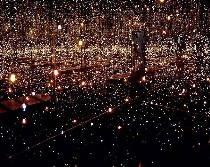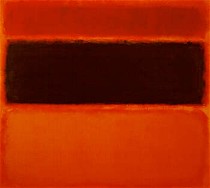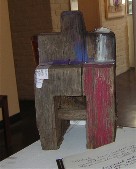 The paths to spirituality are numerous and even Madonna, the anti-Christ herself, has turned into Esther, seeking spiritual enlightenment via the mystical Kabbalah.
The paths to spirituality are numerous and even Madonna, the anti-Christ herself, has turned into Esther, seeking spiritual enlightenment via the mystical Kabbalah.
I’m not being cynical here. I’d have to come down on the side of spirituality as a basic human need. So it’s no wonder that so many artists are putting forth work in that spirit.
The question is, why does some of it succeed and some of it not succeed. I’ve seen a lot lately, and the hallmarks of success, while not completely consistent, suggest some approaches work better, some worse.
The bottom line is that for betting on the ponies and betting on godhead, you gotta have a system.
And it’s gotta be intense.
Loose and airy doesn’t do the trick. Pastelly doesn’t do the trick. Gesture doesn’t do the trick.
Here’s a random very short list of a few of the artists who succeed in my book:
 Jacob el Hanani
Jacob el Hanani
Bruce Pollock
Mark Rothko (image left, “No. 36, Black Stripe”)
Mary Judge
Yayoi Kusama (image top, “Fireflies”)
Vija Celmins
Some of them may not even think of themselves as doing spiritual work. But that’s how I see it, because each of these people puts me in touch with the wonder of the universe, the wonder of life, and the wonders of inner and outer space .
I think that if you want to capture that feeling of awe so someone else can follow you there, you’ve got to go somewhere intense, and not just dance with the colors or the pleasure of the mark-making.
What put me on this topic was the number of AbEx works I’ve seen lately, so many of them a sort of earth worship that just doesn’t translate to a viewer.
A couple of artists at Third Street Gallery (I went there because I know one of them, Carol Wisker) are exploring things spiritual.
 Wisker’s work was pretty, with the more systematic, compressed work packing a stronger punch than the diffuse colors with the larger scale (image, a smaller piece, “103 degrees, Arizona”). Most of the works were named after places in the desert, but imagery in the larger pieces, for the most part, disintegrated in the pastelly colors.
Wisker’s work was pretty, with the more systematic, compressed work packing a stronger punch than the diffuse colors with the larger scale (image, a smaller piece, “103 degrees, Arizona”). Most of the works were named after places in the desert, but imagery in the larger pieces, for the most part, disintegrated in the pastelly colors.
Michael Sebright’s main effort, a huge installation made with Justin S. Proudly, announced its material presence too loudly, drowning out any larger message. I found some pleasure in passages–the moving hardware, the sand on the floor, the sense of Shoji screens and seashore homes.
But Sebright’s concern seemed to be about sacred spaces. He calls the installation “Passage: Gate,” and included a Biblical quote on the wall. Sebright included a lot of verbiage about sacredness in his statement as well. And a bunch of fragile architectural assemblages included collaged passages in which the words “sacred space” turned up more than once–but the message seemed confused.
 The star of the show was small and dense, a sort of architectural Venus of Willendorf, a chunk of distressed wood with a space carved out of its center, some words (again archaic mumbo jumb to me) collaged on (image left). This one held a spirit in its core.
The star of the show was small and dense, a sort of architectural Venus of Willendorf, a chunk of distressed wood with a space carved out of its center, some words (again archaic mumbo jumb to me) collaged on (image left). This one held a spirit in its core.









